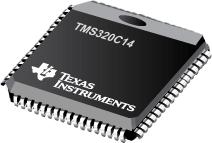●TMS320C10
●The "C10 provides the core CPU used in all other "C1x devices. Its microprocessor operates at 5 MIPS. It provides a parallel I/O of 8 × 16 bits. Three versions with cycle times of 160, 200, and 280 ns are available as illustrated in Table 1. The "C10 versions are offered in plastic 40-pin DIP or a 44-lead PLCC packages.
●TMS320C14/E14/P14
●The "C14/E14/P14 devices, using the "C10 core CPU, offer expanded on-chip RAM, and ROM or EPROM ("E14/P14), 16 pins of bit selectable parallel I/O, and I/O mapped asynchronous serial port, four 16-bit timers, and external/internal interrupts. The "C14 devices can provide for microcomputer/microprocessor operating modes. Three versions with cycle times of 160-ns are available as illustrated in Table 1. These devices are offered in 68-pin plastic PLCC or ceramic CER-QUAD packages.
●TMS320C15/E15/P15
●The "C15/E15/P15 devices are a version of the "C10, offering expanded on-chip RAM, and ROM or EPROM ("E15/P15). The "P15 is a one-time programmable (OTP), windowless EPROM version. These devices can operate in the microcomputer or microprocessor modes. Five versions are available with cycle times of 160 to 200 ns (see Table 1). These devices are offered in 40-pin DIP, 44-pin PLCC, or 44-pin ceramic packages.
●TMS320LC15
●The "LC15 is a low-power version of the "C15, utilizing a VDD of only 3.3-V. This feature results in a 2.3: 1 power requirement reduction over the typical 5-V" C1x device. It operates at a cycle time of 250 ns. The device is offered in 40-pin DIP or 44-lead PLCC packages.
●TMS320C16
●The "C16 offers on-chip RAM of 256-words, an expanded program memory of 65K-words, and a fast instruction cycle time of 114 ns (8.77 MIPS). It is offered in a 64-pin quad flat-pack package.
●TMS320C17/E17/P17
●The "C17/E17/P17 versions consist of five major functional units: the "C15 microcomputer, a system control register, a full-duplex dual channel serial port, u-law/A-law companding hardware, and a coprocessor port. The dual-channel serial port is capable of full-duplex serial communication and offers direct interface to two combo-codecs. The hardware companding logic can operate in either u-law or A-law format with either sign-magnitude or twos complement numbers in either serial or parallel modes. The coprocessor port allows the "C17/E17/P17 to act as a slave microcomputer or as a master to a peripheral microcomputer.
●The "P17 utilizes a one-time programmable (OTP) windowless EPROM version of the "E17.
●TMS320LC17
●The "LC17 is a low-power version of the "C17, utilizing a VDD of only 3.3-V. This feature results in a 2.3: 1 power requirement reduction over the typical 5-V "C1x device. It operates at a cycle time of 278 ns.
● Performance Up to 8.77 MIPs
● All TMS320C1x Devices are Object Code Compatible
● 144/256-Word On-Chip Data RAM
● 1.5K/4K/8K-Word On-Chip Program ROM
● 4K-Word On-Chip Program EPROM (TMS320E14/P14/E15/P15/E17/P17)
● One-Time Programmable (OTP) Versions Available (TMS320P14/P15/P17)
● EPROM Code Protection for Copyright Security
● 4K/64K-Word Total External Memory at Full Speed
● 32-Bit ALU/Accumulator
● 16 × 16-Bit Multiplier With a 32-Bit Product
● 0 to 16-Bit Barrel Shifter
● Eight Input/Output Channels
● Dual-Channel Serial Port
● Simple Memory and I/O Interface
● 5-V and 3.3-V Versions Available (TMS320LC15/LC17)
● Commercial and Military Versions Available
● Operating Free-Air Temperature . . . 0°C to 70°C
● Packaging: DIP, PLCC, Quad Flatpack, and CER-QUAD
● CMOS Technology:
● Device..................Cycle Time
● TMS320C10 . . . . . 200-ns
● TMS320C10-14 . . 280-ns
● TMS320C10-25 . . 160-ns
● TMS320C14 . . . . .160-ns
● TMS320E14 . . . . . 160-ns
● TMS320P14 . . . . . 160-ns
● TMS320C15 . . . . . 200-ns
● TMS320C15-25 . . 160-ns
● TMS320E15 . . . . . 200-ns
● TMS320E15-25 . . .160-ns
● TMS320LC15 . . . . 250-ns
● TMS320P15 . . . . . 200-ns
● TMS320C16 . . . . . 114-ns
● TMS320C17 . . . . . 200-ns
● TMS320E17 . . . . . 200-ns
● TMS320LC17 . . . . 278-ns
● TMS320P17 . . . . . 200-ns



